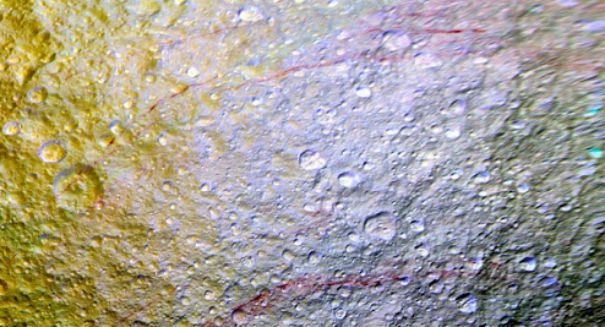-
Tips for becoming a good boxer - November 6, 2020
-
7 expert tips for making your hens night a memorable one - November 6, 2020
-
5 reasons to host your Christmas party on a cruise boat - November 6, 2020
-
What to do when you’re charged with a crime - November 6, 2020
-
Should you get one or multiple dogs? Here’s all you need to know - November 3, 2020
-
A Guide: How to Build Your Very Own Magic Mirror - February 14, 2019
-
Our Top Inspirational Baseball Stars - November 24, 2018
-
Five Tech Tools That Will Help You Turn Your Blog into a Business - November 24, 2018
-
How to Indulge on Vacation without Expanding Your Waist - November 9, 2018
-
5 Strategies for Businesses to Appeal to Today’s Increasingly Mobile-Crazed Customers - November 9, 2018
Mysterious, Graffiti-Like Red Arcs Discovered On Saturn’s Icy Moon Tethys
Here, the giant impact basin Odysseus on Saturn’s moon Tethys stands out brightly from the rest of the illuminated icy crescent.
Advertisement
Tethys’ dark side (at right) is faintly illuminated by reflected light from Saturn.
The snaps were taken as Cassini flew by the giant planet on April 11, using its narrow-angle camera at an altitude of about 53,000km (33,000 miles) from the surface of Tethys. Explainations being studied include theories that the reddish material is exposed ice with chemical impurities, or the result of outgassing from inside Tethys.
According to Paul Helfenstein, a scientist at Cornell University working on the Cassini imaging team, the red arcs should definitely be geologically young for the reason that they cut across some older features such as impact craters; however, their age in years is not known.
NASA’s Jet Propulsion Laboratory (JPL), also responsible for designing the 6.8 meter-tall (22.3ft) spacecraft and its onboard gear, writes on its website that the photos were taken “using clear, green, infrared, and ultraviolet special filters… combined to create enhanced-color views” which underline the striking features that, otherwise would not have been visible to the naked eye. Red features are rare on Saturn’s 62 moons, NASA said, except for a few areas on crater-covered Dione. “It is surprising how extensive these features are”, said Cassini participating scientist Paul Schenk from the Lunar and Planetary Institute in Houston. Another suggestion is that they are the result of fractures that can not be seen with the current resolution of the images. The area of Tethys shown here is centered on 30 degrees north latitude, 187 degrees west longitude, and measures 305 by 258 miles (490 by 415 kilometers) across. The original color images were obtained at a resolution of about 2,300 feet (700 m) per pixel on April 11, 2015.
According to the scientists, the origin of these features and their reddish color remains a mystery. Other red features have previously been seen on Jupiter’s moon Europa, the surface of which is geologically young.
Advertisement
‘We are planning an even closer look at one of the Tethys red arcs in November to see if we can tease out the source and composition of these unusual markings.’. The photos have been captured with the help of NASA’s Cassini spacecraft, which arrived in Saturn’s system in 2004 and will continue to circle its atmosphere until 2017.




























